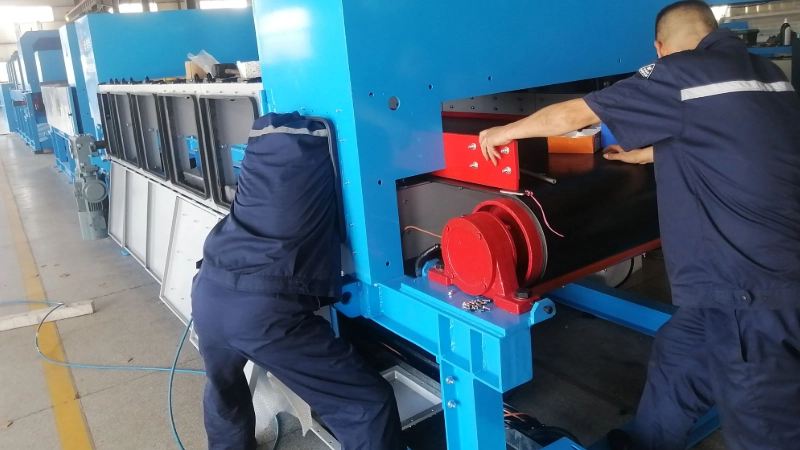Mining Dry Sorting Machine Has A Place of Great Use in Kazakhstan
Release time: 2025-03-24
In the heart of the Eurasian continent, there is a low-key and luxurious “mining kingdom” — Kazakhstan, which spans Europe and Asia. This country is comparable in size to Western Europe, but few people can associate it with the word “tycoon”. But today, I want to tell you that Kazakhstan is not just a vast desert and grassland, it is also the “invisible rich man” in the global mining industry, the treasures it owns are enough to attract the attention of the whole world!
When most people think of Kazakhstan, they may think of endless deserts and sparse sheep, however, the truth is often hidden under the ordinary. This country is like a hidden martial arts master. It looks quite ordinary on the outside, while actually very powerful inside. With the help of intelligent X-ray mining dry sorting machine, Kazakhstan has astonishing mineral resources. How many mines does Kazakhstan have? Next, let’s take stock of them one by one.
(1) First, let’s start with iron ore(for Metallic Ore Sorting). Kazakhstan’s iron ore is simply the “tall, rich and handsome” gossif man in the mining industry. Its iron content is as high as 65%, and its reserves rank 6th in the world. If all of this iron ore is mined, how many locomotives and large ships will be built with it? This is not just a pile of numbers, but also a direct reflection of the country’s industrial strength.
(2) But iron ore is just the tip of the iceberg. Manganese and copper ore(for Metallic Ore Sorting) are also not to be underestimated. Kazakhstan’s manganese ore reserves are the 1st in Asia, and its copper ore reserves are ranked 4th in the world after Chile, United States and Indonesia. These 2 kinds of metals are the blood of modern industry. From smartphones to skyscrapers, everything relies on their support. Kazakhstan is supplying the world with a steady stream of “industrial energy” by these precious minerals.
(3) However, the real highlight is yet to come. Bauxite and chromium ore(for Metallic Ore Sorting), these two minerals have made Kazakhstan famous in the mining industry. Bauxite is a must-have for manufacturing industries such as aircraft, wires, and automobiles. Kazakhstan’s bauxite reserves are among the top 10 in the world. This is simply a “chosen place” for Bauxite ore. Chromium ore is the pride of Kazakhstan, which is known as the “Chrome Mountain”. Kazakhstan’s chromium reserves account for 1/3 of the world’s total, making it a veritable “leader” in the chromium industry. China, as a major buyer of chromium ore, imports a large amount of chromium ore from Kazakhstan every year. The win-win cooperation behind this makes the people of both countries very happy.
(4) But Kazakhstan’s treasures are far more than that. It also has fossil energy such as oil, natural gas, and coal ore(for Coal Mine Dry Sorting). The country’s oil reserves are over 10 billion tons, its natural gas reserves are so large that they can circle the earth several times, and its coal ore reserves are ranked 8th in the world. These energy sources are not only the “nuclear power” of Kazakhstan’s national development, but also an important participant in the global energy market.
(5) What is even more amazing is that, Kazakhstan also has rich gold and uranium ore(for Metallic Ore Sorting). Its gold reserves rank 8th in the world, and its uranium reserves ranks 2nd in the world, second only to Australia. The uranium ore is the “food” of nuclear power plants. Once Kazakhstan’s uranium “granary” is full, nuclear power plants all over the world will smile.
With the global emphasis on sustainable development and environmental protection, Kazakhstan is also facing new challenges and opportunities. How to protect this magical land while developing and utilizing mineral resources has become the focus attention of Kazakhstan government and all sectors of society. In recent years, with the help of ore solid waste X-ray sorting machine, Kazakhstan has increased its investment in environmental protection technologies, promoted green mining and circular economy models, and strived to protect this green land while developing its economy.
However, as an old Chinese saying goes, “Mountains of gold and silver, are not as valued as green waters and lush mountains.” While enjoying the wealth brought by minerals, we should also think about how to balance the relationship between economic development and environmental protection. What will be the future of Kazakhstan? Will it continue to shine in the world as a “rich man in the mining industry”, or will it be able to achieve sustainable development while protecting its environment? All of this is worth waiting for.


